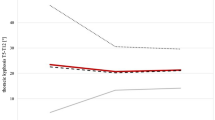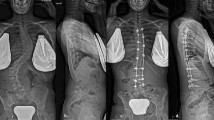Abstract
Purpose
Adolescent idiopathic scoliosis (AIS) is a tridimensional deformity characterized by coronal and sagittal profiles changes. We present a series of 62 patients affected by AIS and treated by thoracic Universal Clamps and transpedicular lumbar screws hybrid system.
Methods
Mean age was 13 years. Average pre-operative Cobb angle was 63° ± 12°. Patients were divided into two groups depending on the kyphosis angle: lower than 45° (51 patients, 82.3 %, mean 21° ± 3°) and higher than 45° (11 patients, 17.7 %, mean 62° ± 6°).
Results
The average percentage of coronal correction was 70 ± 3 % (mean post-operative Cobb angle 19° ± 4°, P < 0.001). In patients with pre-operative physiological thoracic kyphosis–hypokyphosis, we observed an increase in the average value (32° ± 4°, P < 0.001), while in patients with pre-operative hyperkyphosis, mean decrease of thoracic kyphosis was 19° ± 3° (43° ± 4°, P < 0.001).
Conclusions
This case-series study showed the efficacy and safety of Universal Clamp hybrid system in correcting coronal deformity and restoring physiological thoracic kyphosis in patients affected by AIS.


Similar content being viewed by others
References
Hwang SW, Samdani AF, Tantorski M, Cahill P, Nydick J, Fine A, Betz RR, Antonacci MD (2011) Cervical sagittal plane decompensation after surgery for adolescent idiopathic scoliosis: an effect imparted by postoperative thoracic hypokyphosis. J Neurosurg Spine 15:491–496. doi:10.3171/2011.6
Kim YJ, Lenke LG, Bridwell KH, Kim J, Cho SK, Cheh G, Yoon J (2007) Proximal junctional kyphosis in adolescent idiopathic scoliosis after 3 different types of posterior segmental spinal instrumentation and fusions: incidence and risk factor analysis of 410 cases. Spine 32:2731–2738
Ghiselli G, Wang JC, Bhatia NN, Hsu WK, Dawson EG (2004) Adjacent segment degeneration in the lumbar spine. J Bone Jt Surg Am 86:1497–1503
Ilharreborde B, Morel E, Mazda K, Dekutoski MB (2009) Adjacent segment disease after instrumented fusion for idiopathic scoliosis: review of current trends and controversies. J Spinal Disord Tech 22:530–539. doi:10.1097/BSD.0b013e31818d64b7
Vora V, Crawford A, Babekhir N, Boachie-Adjei O, Lenke L, Peskin M, Charles G, Kim Y (2007) A pedicle screw construct gives an enhanced posterior correction of adolescent idiopathic scoliosis when compared with other constructs: myth or reality. Spine 32:1869–1874
Senaran H, Shah SA, Gabos PG, Littleton AG, Neiss G, Guille JT (2008) Difficult thoracic pedicle screw placement in adolescent idiopathic scoliosis. J Spinal Disord Tech 21:187–191. doi:10.1097/BSD.0b013e318073cc1d
Upendra BN, Meena D, Chowdhury B, Ahmad A, Jayaswal A (2008) Outcome-based classification for assessment of thoracic pedicular screw placement. Spine 33:384–390. doi:10.1097/BRS.0b013e3181646ba1
Ebraheim NA, Lu J, Yang H, Heck BE, Yeasting RA (1997) Anatomic considerations of the second sacral vertebra and dorsal screw placement. Surg Radiol Anat 19:353–357
Esses SI, Sachs BL, Dreyzin V (1993) Complications associated with the technique of pedicle screw fixation. A selected survey of ABS members. Spine 18:2231–2238
Vaccaro AR, Rizzolo SJ, Allardyce TJ, Ramsey M, Salvo J, Balderston RA, Cotler JM (1995) Placement of pedicle screws in the thoracic spine. Part I: morphometric analysis of the thoracic vertebrae. J Bone Jt Surg Am 77:1193–1199
Mazda K, Ilharreborde B, Even J, Lefevre Y, Fitoussi F, Penneçot GF (2009) Efficacy and safety of posteromedial translation for correction of thoracic curves in adolescent idiopathic scoliosis using a new connection to the spine: the Universal Clamp. Eur Spine J 18:158–169. doi:10.1007/s00586-008-0839-y
Ilharreborde B, Even J, Lefevre Y, Fitoussi F, Presedo A, Penneçot GF, Mazda K (2010) Hybrid constructs for tridimensional correction of the thoracic spine in adolescent idiopathic scoliosis: a comparative analysis of universal clamps versus hooks. Spine 35:306–314. doi:10.1097/BRS.0b013e3181b7c7c4
Winter RB, Lonstein JE, Denis F (2007) How much correction is enough? Spine 32:2641–2643
Lowenstein JE, Matsumoto H, Vitale MG, Weidenbaum M, Gomez JA, Lee FY, Hyman JE, Roye DP Jr (2007) Coronal and sagittal plane correction in adolescent idiopathic scoliosis: a comparison between all pedicle screw versus hybrid thoracic hook lumbar screw constructs. Spine 32:448–452
Di Silvestre M, Bakaloudis G, Lolli F, Vommaro F, Martikos K, Parisini P (2008) Posterior fusion only for thoracic adolescent idiopathic scoliosis of more than 80 degrees: pedicle screws versus hybrid instrumentation. Eur Spine J 10:1336–1349. doi:10.1007/s00586-008-0731-9
Luhmann SJ, Lenke LG, Erickson M, Bridwell KH, Richards BS (2012) Correction of moderate (<70 degrees) Lenke 1A and 2A curve patterns: comparison of hybrid and all-pedicle screw systems at 2-year follow-up. J Pediatr Orthop 32:253–258. doi:10.1097/BPO.0b013e3182471c74
La Rosa G, Giglio G, Oggiano L (2011) Surgical treatment of neurological scoliosis using hybrid construct (lumbar transpedicular screws plus thoracic sublaminar acrylic loops). Eur Spine J 20:S90–S94. doi:10.1007/s00586-011-1751-4
La Rosa G, Giglio G, Oggiano L (2012) Sagittal profile control in patients affected by neurological scoliosis using Universal Clamps: a 4-year follow-up study. Eur Spine J 21:S32–S36. doi:10.1007/s00586-012-2237-8
Luque ER (1989) Segmental spinal instrumentation in neuromuscular scolioses. Orthopade 18:128–133
Cotrel Y, Dubousset J (1984) A new technic for segmental spinal osteosynthesis using the posterior approach. Rev Chir Orthop Repar Appar Mot 70:489–494
Imrie M, Yaszay B, Bastrom TP, Wenger DR, Newton PO (2011) Adolescent idiopathic scoliosis: should 100% correction be the goal? J Pediatr Orthop 31:S9–S13. doi:10.1097/BPO.0b013e3181fd8a24
Clements DH, Betz RR, Newton PO, Rohmiller M, Marks MC, Bastrom T (2009) Correlation of scoliosis curve correction with the number and type of fixation anchors. Spine 34:2147–2150. doi:10.1097/BRS.0b013e3181adb35d
Mladenov KV, Vaeterlein C, Stuecker R (2011) Selective posterior thoracic fusion by means of direct vertebral derotation in adolescent idiopathic scoliosis: effects on the sagittal alignment. Eur Spine J 20:1114–1117. doi:10.1007/s00586-011-1740-7
Schmidt C, Liljenqvist U, Lerner T, Schulte TL, Bullmann V (2011) Sagittal balance of thoracic lordoscoliosis: anterior dual rod instrumentation versus posterior pedicle screw fixation. Eur Spine J 20:1118–1126. doi:10.1007/s00586-011-1784-8
Sale de Gauzy J, Jouve JL, Accadbled F, Blondel B, Bollini G (2011) Use of the Universal Clamp in adolescent idiopathic scoliosis for deformity correction and as an adjunct to fusion: 2-year follow-up. J Child Orthop 5:273–282. doi:10.1007/s11832-011-0357-z
Ilharreborde B, Vidal C, Skalli W, Mazda K (2013) Sagittal alignment of the cervical spine in adolescent idiopathic scoliosis treated by posteromedial translation. Eur Spine J 22:330–337. doi:10.1007/s00586-012-2493-7
Lafage V, Schwab F, Skalli W, Hawkinson N, Gagey PM, Ondra S, Farcy JP (2008) Standing balance and sagittal plane spinal deformity: analysis of spinopelvic and gravity line parameters. Spine 33:1572–1578. doi:10.1097/BRS.0b013e31817886a2
Lafage V, Schwab F, Patel A, Hawkinson N, Farcy JP (2009) Pelvic tilt and truncal inclination: two key radiographic parameters in the setting of adults with spinal deformity. Spine 34:E599–E606. doi:10.1097/BRS.0b013e3181aad219
Remes V, Helenius I, Schlenzka D, Yrjönen T, Ylikoski M, Poussa M (2004) Cotrel-Dubousset (CD) or universal spine system (USS) instrumentation in adolescent idiopathic scoliosis (AIS): comparison of midterm clinical, functional, and radiologic outcomes. Spine 29:2024–2030
Conflict of interest
None.
Author information
Authors and Affiliations
Corresponding author
Rights and permissions
About this article
Cite this article
La Rosa, G., Giglio, G. & Oggiano, L. The Universal Clamp hybrid system: a safe technique to correct deformity and restore kyphosis in adolescent idiopathic scoliosis. Eur Spine J 22 (Suppl 6), 823–828 (2013). https://doi.org/10.1007/s00586-013-3014-z
Received:
Revised:
Accepted:
Published:
Issue Date:
DOI: https://doi.org/10.1007/s00586-013-3014-z




